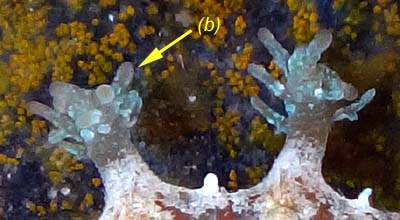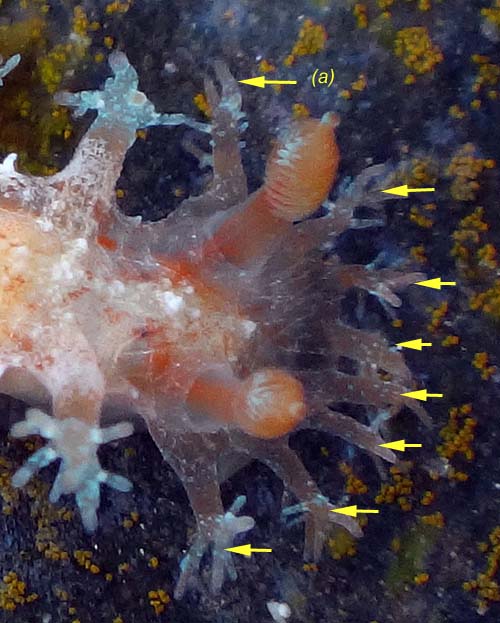This species has been observed on Reunion Island
The body is transparent with white opaque coloration. This species is distinguished by the opaque white coloration, never reported before for a Kaloplocamus species There are four smooth pairs of lateral appendages with ramifications in the apex only. These ramifications are rounded, almost globular and there are many of them resembling in shape to a bunch of grapes. There are eight velar appendages The three tripinnate branchial leaves, are a translucent red-carmine. The rhinophores are of the same color as the branchial leaves, but more translucent with white dots on the apex |
 |
|
| Showing species characteristics... | Photo
Alexandre Laporte |
|
Remarks :
Identification confirmed by David Behrens and Nathalie Yonow
Synonymous (according worms) :
- No synonymous
Bibliographic data :
The body color of the animal is transparent with opaque white coloration. The dorsal and central portions of the dorsum, the posterior end of the foot, the eight velar appendages and the apex of thre lateral appendage are less white opaque than the rest of the body
There are four pairs of lateral appendages. They are smooth with ramifications in the apex only. Instead of being sharp and long these ramifications are rounded, almost globular and there are many of them resembling in shape to a bunch of grapes. These ramifications only occur on the exterior portion of the lateral appendage, with the interior portion being smooth over its entire length.
The long, large, lateral appendages are totally opaque white except at the apex, where they ramify and become more cream in tone
The presence of four ramified appendages that are of the same length and are typical of the genus and the ramifications shape (similar to a bunch of grapes) makes this species unique.
Etymology : This species is named ‘‘dokte'' for the father of the senior author, whose nickname in Haitian kreol is Dokte
Références :
Philippines Nudibranches and Seaslug : Kaloplocamus dokte
Nudibranchs - Sunshine Coast kaloplocamus dokte
Publications :
Vallès Y. & Gosliner T.M. 2006. Shedding light onto the genera (Mollusca: Nudibranchia) Kaloplocamus and Plocamopherus with description of new species belonging to these unique bioluminescent dorids . The Veliger 48(3): 178-205
Other photos of Kaloplocamus dokte :
Reunion, Etang salé on the rocky coast, less 1 m, 23 October 2016, size : 10 mm
There are eight (a) velar appendages The lateral appendage ramifications are rounded, almost globular and there are many of them resembling in shape to a bunch of grapes (b).
 |
 |
.jpg) |
Christophe Cadet Reunion, Etang salé on the rocky coast, less 1 m, 23 November 2010, size : 6 mm The three tripinnate branchial leaves (a), are a translucent red-carmine. But it this small specimen the coloration of the rhinophore is greenish (b)
|
More photos from Indian Ocean
If you have taken a photo of this species in Reunion, Mayotte, Mauritius or Madagascar Islands, please Contact us...
.jpg)